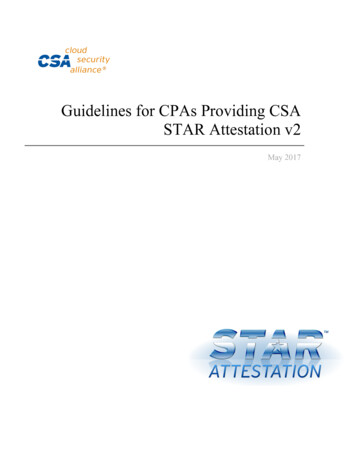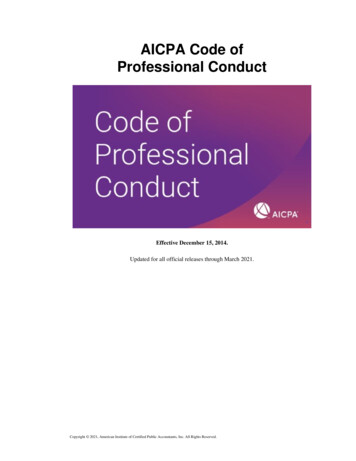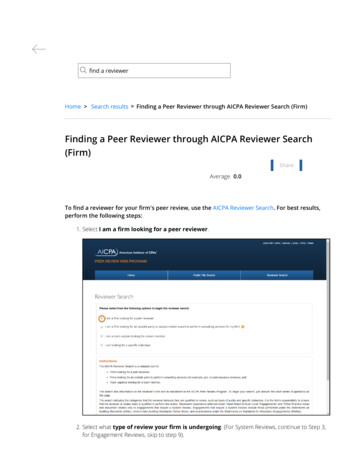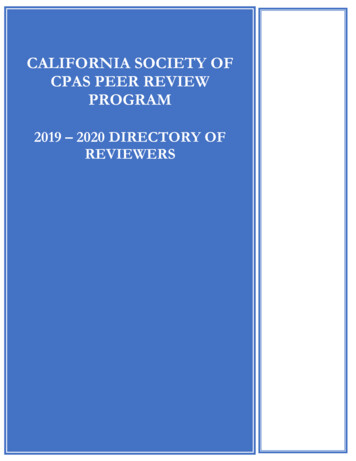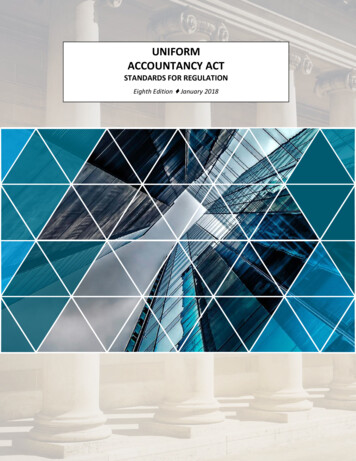
Transcription
Spring 2016College Texts & ResourcesYour classroom.Our content.Their careers.Enhance your Accounting curriculum with real-world publications used by professionalsReview copies available
Working together to shape the world’s futurefinancial professionals.What better resources to use in your classroom than the ones that CPAs, CFOs, financial professionalsand consultants rely on every day for up-to-date information and guidance. AICPA professional materialsare filled with real-world knowledge on the industry’s most pressing issues and critical procedures. Fromthe clarified auditing standards to a full spectrum of accounting topics (both U.S. GAAP and IFRS), thesepublications cover a broad range of topics and can give your students the competitive advantage overtheir peers. Introduce AICPA resources into your curriculum and turn your classroom into one that they’llremember — the classroom that transformed them from students to professionals.Table of ContentsFraud and Business Valuation. 2Management Accounting. 7Accounting & Auditing. 16Not-for-Profit. 21Tax. 23Career and Practice Management. 26AICPA Student Affiliate Membership. 28Academic Resources. 29Review Copy Request Form & Order Information. 30Have an idea for a book?As a thought leader in accounting information for business professionals and practitioners AICPA is aplace to consider publishing. We value the intersection of academics and real world application whereyour insights can take our CPAs and accounting professionals to the next level of competency. AICPA’ scollaborative approach to publishing brings authors and professionals together to deliver cutting edgeaccounting knowledge to scholars, researchers, and practitioners. For information about our publishingprogram and how to submit a book proposal e-mail acquisitions@aicpa.org.Working with the AICPAThe AICPA is constantly looking for reviewers, presenters and authors for its continuing accountingeducation initiatives. We are looking across all subject and topic areas. For more information on howyou can become involved in this program, please email mlcinquiry@aicpa.org.1ORDERS: Call 919.402.4494 or 919.402.2158 Email mdouglass@aicpa.org or dworsley@aicpa.org
Fraud and Business ValuationUnderstanding Business Valuation: A Practical Guide to ValuingSmall to Medium Sized Businesses, Fourth EditionAuthor: Gary R. Trugman, CPA, ABV, MCBA, ASA, MVSInstructor resourcematerials available2012 Hardcover with CD-ROMProduct# PBV1201PISBN 978-1-93735-063-5Valuation of businesses for myriad purposes continues to be a growth area for CPAs.Your students will benefit from the comprehensive foundational knowledge thatUnderstanding Business Valuation provides. This book thoroughly covers the basicsand delivers practical applications for using business valuation theory. Topics includevaluation standards, theory, approaches, methods, discount and capitalization rates,and S corporation issues. Exhibits, tables, boxes, and figures will help your studentsunderstand the topics discussed.An accompanying CD-ROM includes several sample reports and a comprehensivebibliography.New features include recent changes to valuation theory and a chapter on valuationsfor financial reporting.Table of ContentsChapter 1: Overview of Business ValuationChapter 2: Business Valuation StandardsChapter 3: Getting StartedChapter 4: Appraisal Principles and TheoryChapter 5: Data Gathering OutlineChapter 6: Data Analysis OutlineChapter 7: Statistics for Valuation and Economic DamagesChapter 8: Developing Forecasts for Business Valuations and Economic DamagesChapter 9: The Market Approach—Part IChapter 10: The Market Approach—Part IIChapter 11: The Asset-Based ApproachChapter 12: The Income ApproachChapter 13: Discount and Capitalization RatesChapter 14: Premiums and Discounts (Valuation Adjustments)—Part IChapter 15: Premiums and Discounts (Valuation Adjustments)—Part IIChapter 16: Revenue Ruling 59-60Chapter 17: The Valuation ReportChapter 18: Valuation of Pass-Through EntitiesChapter 19: Valuation in Financial ReportingChapter 20: Valuing Intangible Assets: An OverviewChapter 21: Estate and Gift ValuationsChapter 22: Divorce ValuationsChapter 23: Professional Practice ValuationsChapter 24: Shareholder DisputesChapter 25: My Favorite Court CasesChapter 26: Economic DamagesAICPA College Texts – Spring 2016 Complimentary Review Copies Available! See page 30 for details.2
Fraud and Business ValuationWhite Collar Crime: Core Concepts for Consultantsand Expert WitnessesAuthors: Debra K. Thompson, CPA, CFF, CFE and Randall Wolverton, CPA, CFF2012 PaperbackProduct# PFF1202PISBN 978-1-93735-101-4In a perfect world, a fraud investigation follows a methodical process. This resourceequips the student to deal with a fraud investigation in the real world by followinga flexible approach and relying on the authors’ valuable fraud investigation and FBIforensics experience in dealing with the prosecution of white-collar criminals. Presentedin a user-friendly manner, covering core concepts and decisions that determine theoutcome of a fraud investigation, this book provides the student with the knowledgethey need before the investigation begins and shows them how to conduct solidinterviews that can withstand legal challenge. In addition, it covers: An overview of the “perfect” fraud investigation Practical differences between a “perfect” investigation and real investigation Gathering useful information quickly Quickly assessing the pertinent facts – fraud triage Interviewing witnesses Understanding prosecution/defense tactics Antifraud tactics Fraud prevention and detection measuresValuation of Privately-Held-Company Equity Securities Issuedas Compensation — Accounting and Valuation GuideSince the issuance of FASB ASC 718 and 505-50 in 2004, valuing stock-basedcompensation (“cheap stock”) has been a significant challenge for private companies.This guide has been designed to mitigate those challenges. It brings you practicalguidance and illustrations related to accounting, disclosures and valuation of privatelyheld-company equity securities issued as compensation.This guide includes: Evaluating private and secondary market transactions — What should companiesdo when transaction activity doesn’t match their estimates of value?2013 PaperbackProduct# AAGSTK13PISBN 978-1-93735-222-6 Adjustments for control and marketability — How should companies think aboutthe value of the enterprise for the purpose of valuing minority securities? Whenis it appropriate to apply a discount for lack of marketability, and how should theestimated discount be supported? Highly leveraged entities — How should companies incorporate the fair value ofdebt in the valuation of equity securities? What is the impact of leverage on theexpected volatility of various securities? The relevance of ASC 820 (SFAS 157) to cheap stock issues Updated guidance and illustrations regarding the valuation of, and disclosuresrelated to, privately held company equity securities issued as compensationThis Guide also provides expanded and more robust valuation material to reflectadvances in the theory and practice of valuation since 2004.This edition includes guidance from FASB ASC 718, 505-50, 820-10 and SSVS 1 whichwere all issued since the last AICPA guidance dedicated to this issue.3ORDERS: Call 919.402.4494 or 919.402.2158 Email mdouglass@aicpa.org or dworsley@aicpa.org
Fraud and Business ValuationEssentials of Forensic AccountingAuthors: William S. Hopwood, Ph.D., George R. Young, Ph.D., CPA, CFE, Michael A. Crain,CPA, ABV, ASA, CFA, CFE, and Carl Pacini, Ph.D., JD, CPAThe Essentials of Forensic Accounting is an authoritative resource covering a comprehensiverange of forensic accounting topics. As a foundation review, a reference book or aspreparation for the Certification in Financial Forensics (CFF) exam, this publication willprovide thoughtful and insightful examination of the key themes in this field: Professional Responsibilities and Practice Management Fundamental Forensic Knowledge, Laws, Courts, and Dispute ResolutionInstructor resourcematerials available2014 PaperbackProduct# PFF1401PISBN 978-1-94165-110-0 Specialized Forensic Knowledge, Bankruptcy, Insolvency, and ReorganizationThrough illustrative examples, cases and explanations, this book makes abstract conceptscome to life to help students understand and navigate successfully in this complex area.Table of ContentsSection I: IntroductionChapter 1: The Forensic Accounting ProfessionChapter 2: Professional Ethics and ResponsibilitiesSection II: Fundamental Forensic KnowledgeChapter 3: Civil and Criminal ProcedureChapter 4: EvidenceChapter 5: DiscoveryChapter 6: Litigation ServicesChapter 7: Engagement and Practice ManagementSection III: Specialized Forensic KnowledgeChapter 8: Fraud Prevention, Detection, and ResponseChapter 9: Fraud Schemes and ApplicationsChapter 10: Bankruptcy and Related FraudsChapter 11: Digital ForensicsChapter 12: Matrimonial ForensicsChapter 13: Financial Statement MisrepresentationsChapter 14: Economic DamagesChapter 15: Valuation FundamentalsChapter 16: Valuation ApplicationsAppendix A: Fraud-Related LawsOverview of Various Common Law and Statutory Laws Related to FraudSarbanes-Oxley ActFederal Tax CrimesFederal Securities Law Offenses (Securities Fraud)Foreign Corrupt Practices ActFederal False Claims ActFederal Anti-Kickback StatuteStark LawMoney Laundering LawsConspiracyAiding and AbettingObstruction of JusticeAppendix B: Present ValueIntroductionWhy Present Value Is ImportantBasic Math Behind TVM CalculationsComponents of TVM CalculationsSummary and ConclusionGlossaryIndexAICPA College Texts – Spring 2016 Complimentary Review Copies Available! See page 30 for details.4
Fraud and Business ValuationGuide to Intangible Asset ValuationAuthors: Robert F. Reilly, CPA and Robert P. Schweihs, ASAWritten by highly experienced authors, the Guide to Intangible Asset Valuation defines andexplains the disciplined process of identifying assets that have clear economic benefit, andprovides an invaluable framework within which to value these assets. The authors lay outthe critical process that leads students through the description, identification and valuationof intangible assets and will help them to: Describe the basic types of intangible assets Find and identify intangible assets2014 HardcoverProduct# PBV1401PISBN 978-1-94165-146-9 Provide guidelines for valuing those assetsThis indispensable reference focuses strictly on intangible assets. Through illustrativeexamples and clear modeling, this book makes abstract concepts come to life to helpstudents learn to deliver strong and accurate valuations.Table of ContentsChapter 1: Identification of Intangible AssetsChapter 2: Identification of Intellectual Property AssetsChapter 3: Reasons to Conduct an Intangible Asset ValuationChapter 4: Reasons to Conduct an Intangible Asset Economic Damages AnalysisChapter 5: Intangible Asset Valuation PrinciplesChapter 6: Intellectual Property Valuation PrinciplesChapter 7: Intangible Asset Economic Damage PrinciplesChapter 8: Valuation Data Gathering and Due Diligence AnalysisChapter 9: Intangible Asset Economic Damages Due Diligence ProceduresChapter 10: Structuring the Intangible Asset Analysis AssignmentChapter 11: The Intangible Asset Valuation ProcessChapter 12: The Intangible Asset Economic Damages ProcessChapter 13: Highest and Best Use AnalysisChapter 14: Cost Approach Methods and ProceduresChapter 15: Cost Approach Valuation Illustrative ExampleChapter 16: Market Approach Methods and ProceduresChapter 17: Market Approach Valuation Illustrative ExampleChapter 18: Income Approach Methods and ProceduresChapter 19: Income Approach Illustrative ExampleChapter 20: Valuation Synthesis and ConclusionChapter 21: FASBASC 820 and Fair Value AccountingChapter 22: FASBASC 805 and Acquisition AccountingChapter 23: Fair Value of Intangible Assets Not Acquired in a Business CombinationChapter 24: Goodwill under Fair Value AccountingChapter 25: Valuation of Intellectual PropertyChapter 26: Valuation of Contract Intangible AssetsChapter 27: Customer Intangible AssetsChapter 28: Data Processing Intangible AssetsChapter 29: Human Capital Intangible AssetsChapter 30: Licenses and PermitsChapter 31: Technology Intangible AssetsChapter 32: Engineering Intangible AssetsChapter 33: GoodwillChapter 34: Reporting the Results of the Intangible Asset AnalysisSelected Bibliography5ORDERS: Call 919.402.4494 or 919.402.2158 Email mdouglass@aicpa.org or dworsley@aicpa.org
Fraud and Business ValuationTesting Goodwill for Impairment — Accounting and Valuation GuideThis guide provides accounting and valuation guidance for impairment testing of goodwill.Specifically, it focuses on practice issues related to the qualitative assessment.This resource will help students seeking an advanced understanding of the accounting,valuation, and disclosures related to goodwill impairment testing (including the qualitativeassessment). It is also a vital resource for learning about the preparation of financialstatements of public and private companies that follow FASB guidance on goodwill.Covered topics include:2013 PaperbackProduct# AAGGDW13PISBN 978-1-93735-280-6 Fair Value: This guide discusses measuring the fair value of a reporting unit inaccordance with FASB ASC 820, Fair Value Measurement, and illustrates thevaluation techniques often utilized for this purpose. Practice Issues: This guide addresses such issues as identifying reporting units,assigning assets and liabilities to a reporting unit, treatment of shared assetsand liabilities among reporting units, assigning recorded goodwill to reportingunits, when to test goodwill for impairment, consideration of market participantassumptions, performing comparison to market capitalization, and more. New Qualitative Assessment: This guide describes the framework for performingthe optional qualitative assessment, and includes an example that illustrates oneapproach for performing it. Comprehensive Example: This guide includes a comprehensive example of avaluation analysis used for performing steps 1 and 2 of the goodwill impairmenttest. In this example, the discount rate adjustment technique, the guideline publiccompany method, and the guideline company transactions method are usedto determine the fair value of a reporting unit. These are the most frequentlyused methods in practice when determining the fair value of a reporting unit inaccordance with ASC 820. Disclosures: Provides example disclosures which meet the requirements containedin FASB ASC 350-20, as well as those of Item 303 of SEC Regulation S-K.AICPA College Texts – Spring 2016 Complimentary Review Copies Available! See page 30 for details.6
Management AccountingThe AICPA Audit Committee Toolkit: Public CompaniesAuthor: The AICPA Audit Committee Effectiveness Center in cooperation with CNAThis version of the popular audit committee toolkit is written to help students understandhow audit committees of public companies can achieve best practices for managingand incorporating their role in the organization. Now with downloadable content, thisToolkit offers a broad sampling of checklists, matrices, reports, questionnaires and otherpertinent materials specifically tailored to public companies and designed to make auditcommittee best practices actionable.This book includes:2014 PaperbackProduct# PMA1402PISBN 978-1-94023-544-8 Administrative guidelines – including a sample charter matrix, audit committeeroles and responsibilities, and an overview of the AICPA peer review program R oles and responsibilities – with checklists, tools, and guidelines for the auditcommittee, independent auditors, and a sample whistleblower policy andtracking report P erformance evaluation tools – key forms needed to evaluate internal auditteams, independent auditors, and an audit committee self-evaluationThe AICPA Audit Committee Toolkit: Private CompaniesAuthor: The AICPA Audit Committee Effectiveness Center in cooperation with CNAThe AICPA Audit Committee Toolkit: Private Companies is designed to support auditcommittee related issues, including discussion of IFRS. This book takes the guessworkout effectively establishing and managing an audit committee by providing the studentwith dozens of useful tools. Developed specifically for private companies, it provides allof the most common forms, and additional tools tailored for the private company. Theaccompanying downloadable content features forms and checklists that can be filledout and saved to effectively create, file, and track documentation.This book includes:2014 PaperbackProduct# PMA1403PISBN 978-1-94023-546-2 Administrative guidelines – including a sample charter matrix, audit committeeroles and responsibilities, and an overview of the AICPA peer review program R oles and responsibilities – with checklists, tools, and guidelines for the auditcommittee, independent auditors, and a sample whistleblower policy andtracking report P erformance evaluation tools – key forms needed to evaluate internal auditteams, independent auditors, and an audit committee self-evaluation7ORDERS: Call 919.402.4494 or 919.402.2158 Email mdouglass@aicpa.org or dworsley@aicpa.org
Management AccountingStrategic Business Management: From Planning to PerformanceAuthor: Gary CokinsPresenting core theories alongside practical applications, this publication will help studentsunderstand how to effectively move an organization toward strategic goals. Author GaryCokins uses his deep knowledge of the subject matter to deliver an easy-to-follow roadmap to effective and strategic management through: Establishing the integral links between planning and performance Demonstrating how risk management and performance assessment impact planning2012 PaperbackProduct# PCG1305PISBN 978-1-93735-235-6 A pplying business analytics and Big Data in the finance and accounting functionsas well as marketing, sales, operations and other functions Evaluating the effectiveness of a strategy map and the balanced scorecard as amanagement tool Tying budgeting to strategy and measuring the effectiveness of both viaongoing performanceWritten in a plain, straight-forward fashion that will allow students to draw immediate valuefrom its content, this book pulls together several topics in an elegant yet sophisticatedapproach. It uses detailed graphics and diagrams to provide students with a clearunderstanding of the dynamic intersection between key management and organizationleadership topics that management accountants need to master in order to fill a strategicleadership role within their organizations.The Traits of Today’s CFO: A Handbook for Excellingin an Evolving RoleAuthor: Ron Rael, CPA, CGMAAs the business world grows in complexity and increases in pace, organizations expect theleaders of their management accounting teams to be just that — leaders. Crunching thenumbers, running financial reports, and complying with rules and regulations are only apart of contemporary CFOs’ or controllers’ work. Equally important is CFOs’ participationon the executive team as a strategic leader of the finance function, a strong communicator,high-level negotiator, and builder of a collaborative environment.2012 PaperbackProduct# PCG1303PISBN 978-1-93735-223-3This book explores in detail controllers’ and CFOs’ critical traits and explains specificallywhat actions are required to meet these requirements. It provides a wealth of informationon coaching employees and, in the process, transferring accountability for results back totheir hands. It further includes thorough coverage of best practices in governance and riskprograms, gap analysis, shaping organizational culture, and team building.Drawing on studies of executives and leaders of finance teams, The Traits of Today’s CFOdevelops a detailed picture of the contemporary and future controller and CFO and tellsstudents how to prepare for these roles.Includes checklists, self-assessments, position descriptions, coaching exercises, and otherpractical tools.AICPA College Texts – Spring 2016 Complimentary Review Copies Available! See page 30 for details.8
Management AccountingRisk Assessment for Mid-Sized Organisations: COSO Toolsfor a Tailored Approach, 2nd EditionAuthor: Scott McKay, CPA, CPE, CIA, CCSAThis resource offers practical examples and explanations that lay out a clearly definedframework for approaching enterprise risk management from start to finish. It identifiesrisk at the entity level in small and medium size enterprises, and allows students todevelop a tailored approach to an organization’s risk management requirements.2013 PaperbackProduct# PCG1307PISBN 978-1-94023-508-0The publication features tightly written strategies and helpful diagrams that translateCOSO guidelines into tactical plans and also includes a free download containing a setof Excel worksheets that show how following the ERM tactics will impact quantitativefinancial measurements. It also includes a PowerPoint presentation for training othersinvolved in the ERM process.Together, this approach will allow students to create a solid structure for a riskmanagement process that helps them avoid the internal and external risks thatdamaged so many organizations in the recent past. They will be able to: C reate a common language to define, identify, evaluate, and manage risk E stablish and agree on risk tolerances and risk appetite I dentify risk management expectations, current gaps, and risk owners L everage cross-functional expertise to manage risk to within acceptable levelsInternal Control – Integrated Framework (3 volume set)Developed by the Committee on Sponsoring Organizations of the TreadwayCommission (COSO), this new framework consists of three volumes: Executive Summary — The summary provides a high-level overview and laysout the definition and limitations of internal control, and the requirements foran effective system of internal control, including a description of the roles ofcomponents and principles. It highlights several important enhancements andclarifications that are intended to ease use and application of the framework.2013 PaperbackProduct# 990025PISBN 978-1-93735-238-79 F ramework and Appendices — The framework sets forth and describes the fivecomponents and 17 principles of a system of internal control, illustrates manyapproaches and examples relating to entity objectives, and provides directionfor all levels of management to use in designing, implementing and conductinga system of internal control, and in assessing its effectiveness. The appendicesprovide additional reference material, including a glossary of key terminology, adiscussion of roles and responsibilities of both responsible and external parties,and more. I llustrative Tools for Assessing a System of Internal Control (Tools) — Thetools provide illustrative templates and scenarios that may be useful in applyingthe framework and assessing its effectiveness.ORDERS: Call 919.402.4494 or 919.402.2158 Email mdouglass@aicpa.org or dworsley@aicpa.org
Management AccountingMarketing Management for Non-Marketing ManagersAuthor: Heather Fitzpatrick, CPA, CGMAAlthough marketing-related expenses are a significant portion of most organizations’budgets, it is often frustrating for those with budget oversight to get a clear picture ofthe returns on their marketing investment. This engaging book offers practical ways fornon-marketing managers and executives to measure and improve marketing returns.Students will learn: Why market leaders achieve significantly greater returns on their marketing thanothers within their market.2013 PaperbackProduct# PCG1304PISBN 978-1-93735-267-7 The three main reasons most marketing plans fail to live up to their potential, andthe steps to avoid these pitfalls. How to evaluate a marketing investment’s likely ROI before investing the money. When and how to assess the financial returns of marketing efforts.The book includes: Case studies from companies of various sizes and in a cross-section of industries,including not-for-profits Four tests to use prior to the approval of a marketing budget A marketing performance evaluation toolCommunications: Methods and Applications for Financial ManagersAuthor: James CarberryImproving communication is one of the most important — and challenging — issues thatmanagement accountants face. In a global survey of CFOs, Ernst & Young said: “Despitetwo thirds of respondents saying that increasingly they act as the public face of theorganization, most point to communication and influencing as the most important areafor improvement.”In this publication, students will learn: How do management accountants know if they are effectively communicating?2013 PaperbackProduct# PCG1301PISBN 978-1-93735-196-0 What are the most effective techniques for improving their communication skills?This book draws on interviews with finance professionals at every level of corporateaccounting, as well as with communication consultants, executive recruiters andeducators. It looks at how management accountants communicate inside and outsidetheir organizations, identifies best practices, and gives hands-on strategies that studentscan use right away.Students will discover how to: Move their current communication skills to a higher level. Recognize the importance of communication within the context of their financialmanager function. Understand the right way to deliver bad news and resolve conflicts. Manage the impact of new technologies on traditional communication channels. Develop the skills to use active listening as the foundation for positivecommunication tactics.AICPA College Texts – Spring 2016 Complimentary Review Copies Available! See page 30 for details.10
Management AccountingSmart Risk Management: A Guide to Identifying and CalibratingBusiness RisksAuthor: Ron Rael, CPA, CGMAManagement accountants must be able to define the payoffs from their organization’srisk taking, as well as identify, understand, and reduce the negative effects of everydaybusiness risks. This book defines organizational risk taking and outlines a formalprocess to handle risk effectively.The book details six steps for sound risk management: D efining risk2012 PaperbackProduct# PCG1401PISBN 978-1-94023-533-2 Examining your attitude toward risk Analyzing your organization’s ability to handle risk Minimizing a risk’s exposure or downside Recovering quickly from a risk’s negative impacts Expanding your knowledge so you can accept more risk with confidenceWritten for management accountants, Smart Risk Management analyzes your positionin the middle of the organization, both that it does not take risks whose costs it cannotafford and that it takes enough risks to stay competitive in the evolving marketplace.Budgeting, Planning, and Forecasting in Uncertain TimesAuthors: Michael Coveney, Gary CokinsBudgeting, planning and forecasting are critical management tasks that not only impactthe future success of an organization, but can threaten its very survival if done badly.Yet in spite of their importance, the speed and complexity of today’s businessenvironment has caused a rapid decrease in the planning time horizon. As aconsequence, the traditional planning processes have become unsuitable for mostorganization’s needs.In this book, students will find new, original insights, including:2014 PaperbackProduct# PCG1306PISBN 978-1-94023-531-8 7 planning models that every organization needs to plan and manageperformance 6 ways in which performance can be viewed A planning framework based on best management practices that can copewith an unpredictable business environment The application of technology to planning and latest developments in systems Results of the survey conducted for the book on the state of planning inorganizations11ORDERS: Call 919.402.4494 or 919.402.2158 Email mdouglass@aicpa.org or dworsley@aicpa.org
Management AccountingStrategy and Risk Management: An Integrated Practical ApproachAuthor: Ron Rael, CPA, CGMAEmployees make dozens of day-to-day decisions — and any one of them could comeback to haunt them, even when the decision does not seem to have hidden or unknownramifications. That is why an organization must have a protocol in place for identifying andmitigating all major business risks long before it is needed.2012 PaperbackProduct# PCG1309PISBN 978-1-94023-521-9At the strategic level, risk management and strategic management are intertwined. Usingthis book, students learn how to apply powerful tools and approaches to make planningprocesses more effective and flexible and build a set of decision-making processes basedon plain language. Author, Ron Rael, uses quality concepts/language (TQM & Six Sigma)to define the Enterprise Risk Management (ERM) process and value of prevention, whileshowing how these elements are both necessary and highly desired in an organization’sstrategic decision-making.ERM extends to everyday business decisions because employees take actions and makedaily choices that could have a detrimental effect o
AICPA College Texts – Spring 2016 Complimentary Review Copies Available! See page 30 for details. Testing Goodwill for Impairment — Accounting and Valuation Guide This guide provides accounting and valuation guidance for impairment testing of goodwill. Specifically, it focuses

